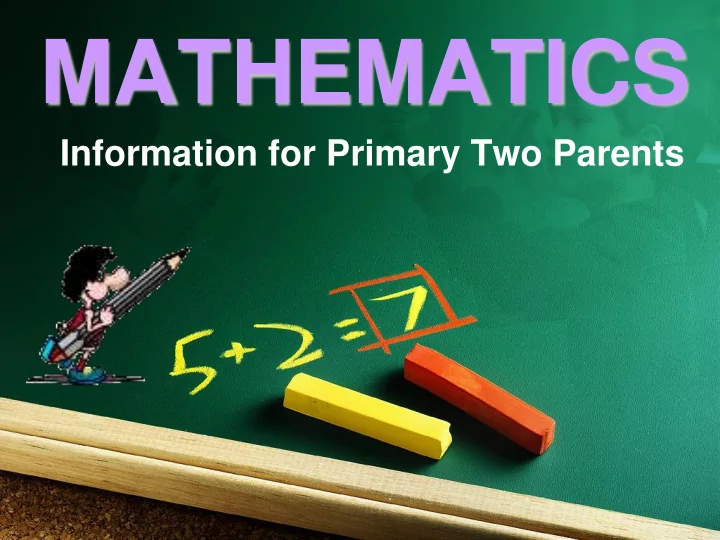

MATHEMATICS Information for Primary Two Parents
Primary Primary Mathem Mathematics atics (Laying (Laying a str a strong foundati ong foundation) on) The Primary Mathematics syllabus aims to enable all students to: • Acquire mathematical concepts and skills for everyday use and for continuous learning in Mathematics. • Develop thinking, reasoning, communication, application and metacognitive skills through a mathematical approach to problem solving; and • Build confidence and foster interest in Mathematics
Our Vision A Creative, Innovative and Effective Mathematics Problem Solver
Mathematics Framework
Syllabus Organisation
P2 Syllabus Number & Algebra (Strand) Numbers up to 1000 Addition & subtraction Multiplication & division Fraction of a whole Addition and subtraction – Fraction Money
P2 Syllabus Measurement & Geometry (Strand) Length, Mass & Volume Time 2D shapes 3D shapes
P2 Syllabus Statistics (Strand) Picture graphs with scales Mathematical Processes Reasoning, communication & connections Applications Thinking skills & heuristics
Heuristics (P1-P5) 1. Draw a model/diagram 2. Make a systematic list/tabulation 3. Look for patterns 4. Guess and check 5. Act it out 6. Use before-after concept
Heuristics (P1-P5) 7. Work backwards 8. Restate the problem in another way 9. Simplify the problem 10. Make suppositions
Phas Phases es of Le of Learni arning ng • Prior knowledge • Motivating contexts Readiness • Learning environment • Activity- based Learning • Motivated learning • Teacher- Practice • Reflective directed Mastery Engagement inquiry Review • Direct • Extended instruction Learning
Learning Learning Ou Outcom tcomes es 1. Understanding numbers up to thousand 2. Solve mathematical problems involving addition and subtraction 3. Multiple and divide numbers within multiplication tables 4. Identify, name, describe and sort shapes and objects 5. Tell time to 5 minutes 6. Compare and order objects by length, mass, or volume 7. Read and interpret picture graphs with scales 8. Understand fractions
Checkpoin Checkpoints ts Platforms to assess students’ learning include: • Performance task • Experiential learning activities • Presentation • Group work • Daily assignments
P2 Programmes Primary Mathematics Instructional Programme To help students build strong foundation in primary Math through a structured teaching sequence and supporting manipulatives and materials based on the concrete- pictorial-abstract (CPA) approach.
Learning Integrated Support for Math Alive Trail Mathematics Reasoning Money Sense Brain Games Cartoon
P2 Programmes Han Hands ds-on on • Enhance conceptual understanding through use of the Concrete-Pictorial-Abstract approach • Communicate their reasoning and connections through various mathematical tasks and activities. Int Integrate ted d Trails ails • To experience real-life Mathematics around them
P2 Programmes Br BrainGames ainGames • To develop the abilities to reason and apply problem solving skills through games
P2 Programmes Learning S Lear ning Suppor upport f t for Ma or Math th • Provide help for students with weak basic numeracy skills • Students receive more individual attention from teacher • Students learn through hands-on experiences
P2 Programmes Money Sens Money Sense! e! • Able to count amount of money in dollars up to $100 • Understand the value of money • Build confidence and foster interest in Mathematics • Reward system • Make sound decision
P2 Programmes Reas easoning Ca oning Cartoon toon • Develop thinking, reasoning, communication, application and metacognitive skills with the help of our cartoon characters, Chendol, Kachang, Cheng Teng and Cha Cha.
CPA Approach Our approach when teaching Math concepts to young children is from ‘ C oncrete’ to ‘ P ictorial’ to ‘ A bstract’. C-P-A Approach
Experiential eriential Learning rning
Contact Details HOD Ma • leng_sok_wah_celina@schools.gov.sg LH Ma • Lim_li_shan@schools.gov.sg
Recommend
More recommend